 Project 651: 16 SSG Conventional Missile Attack submarines (NATO Juliett).
Project 651: 16 SSG Conventional Missile Attack submarines (NATO Juliett).Soviet Cold War Subs
Pr.613 Whiskey | Pr.611 Zulu | Pr.615 Quebec | Pr.633 Romeo | Pr.651 Juliet | Pr.641 Foxtrot | Pr.641 buki Tango | Pr.877 KiloPr.627 kit November | Pr.659 Echo I | Pr.675 Echo II | Pr.671 Victor I | Pr.671RT Victor II | Pr.671RTMK Victor III | Pr.670/670M skat Charlie | Pr.705 lira Alfa | Pr.949 antey Oscar | Pr.945 Sierra | Pr.971 bars Akula | Pr.885 graney Yasen | Pr. 545 Laika
Pr.629 Golf | Pr.658 Hotel | Pr.667A Yankee | Pr.667B Murena Delta I | Pr.667D Delta II | Pr.667BDR Kalmar Delta III | Pr.667 BDMR delfin Delta IV | Pr. 941 akula Typhoon | Pr.995 borei Dolgorukiy | Pr.09851 Khabarovsk
Project 651 submarines (NATO Juliett) were conventionally powered cruise-missile launching submarines developed in the Soviet Union in the late 1950s as a way to combat US Navy carrier battle groups (CBG). It was planned to mass-produce them, and 35 were ordered initially, until the serie was curtailed to just 16 and 19 cancelled due to the nuclear-powered equivalent ECHO class were made earlier than expected. The Juliett were an interim solution due to expected delays but as Project 659/675 Echo submarines entered service sooner and with more missiles, the Juliett
program was curtailed. They were built at Baltic Shipyard in Leningrad and Krasnoye Sormovo Shipyard in Gorky 1960-68 and served until 1994, so for about thirty years despite their limitations.
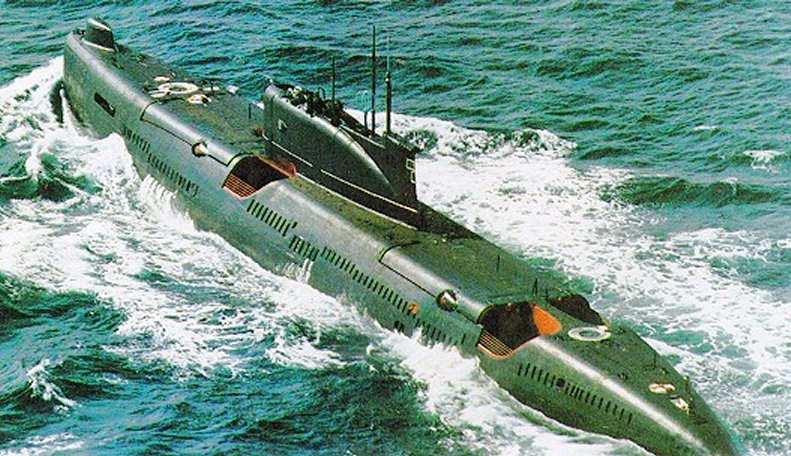
Development
Project 651 submarines (NATO classification Juliett class) were born from the need to align a fleet of assets with stealth and long reach in order to deal with US Navy carrier battle groups. Surface ships, like the Kynda class cruisers of the early 1960s and their successors, were easy to pick up by radar or naval reconnaissance, while submarines were not. The first generation of conventional attack boats such as the Whiskey, Quebec, Zulu, Romeo or Foxtrot had to close to their targets to fire their torpedoes, meaning dangerously close or inside the multiple layers of these carrier battle groups. Thus the “missile mafia” under the Khrushchev era, with admiral Kuznetsov at the forefront, proposed a new strategy, still relatively untapped at the time: Cruise missiles submarines. They would have the long range perfect to be safe from anything but the most distant ASW patrols.
The USA tested Gato class conversions such as the Grayback class under the Regulus program, but only tested two boats and later the USS Halibut but in the process of acquiring naval deterrence, leading to their first SSBNs. They were not intended at striking Soviet surface groups. Thus, it was tempting for the Soviet Navy, always searching way to reduce their naval power imbalance compared to the USN, to look for new solutions, the first of which being Whiskey class conversion prototypes (the first SSGs) and the ECHO class, first SSGNs (nuclear-powered for extra speed and range). These however were costly and it was looked after a cheaper, smaller conventional alternative that could be mass-produced and provide the saturation effect needed to just defeat these layered defences.
Project 651 were also designed from 1957 as an alternative to Project 659 boats (ECHO I) as it was feared they would be delayed dfue to their more complicated conception as nuclear submarines, quite new at the time. They emerged at the same time as the Project 627 (NOVEMBER) attack submarines indeed. Soviet diesel-electric submarines armed with cruise missiles were seen as a good alternative at the time nuclear reactors were in high demand and short supply, and 39 were ordered when plans were finalized and accepted in 1959. It should be noted that in addition to CBGs they would participate to Soviet nuclear deterrence, as these missiles could be nuclear-tipped for a strike capability against the US east coast targets.
The design team was headed by Abram Samuilovich Kassatsier, one prominent name in submarine design circles in USSR. They were entirely tailored around their missiles launchers, similar to those on the ECHO class, and with a range of approximately 300 nautical miles (560 km). The initial specifications stated that a full salvo of four would be done while surfaced in acceptable weather and under less than four knots (7.4 km/h).
Design of the class

Hull and general design
Project 651 boats were a double-hulled design displacing 3,174 metric tons (3,124 long tons) surfaced, 3,750 tonnes (3,690 long tons) submerged, via an overall length of 85.9 meters (281 ft 10 in) and beam of 9.7 meters (31 ft 10 in) but moreover a draft of 6.29 meters (20 ft 8 in) making these quite “stubby”, like ECHOs with a fews section removed. Test depth was a relatively comfortable (for 1960) 240 meters (790 ft) with a design depth of 300 meters (980 ft) and crush depth point probably in excess of 350 m.
The main issue of the design however was their prominent blast deflectors cut out at the back of their missile launchers in the outer hull. In addition to their classic diesel-electric propulsion, this made them very noisy at high speed and easy to detect. Thuis was however compensated by other measures: A low magnetic signature using austenitic steel double hull covered by 2 inches or 51 mm of thick black tiles made of sound-absorbing hard rubber. Like previous attempts, these bricks degraded fast and just fell off over time. Another measure was the set of shock and vibration buffering measures in the powerplant. The chassis of the diesels and gears were placed on suspended frames.
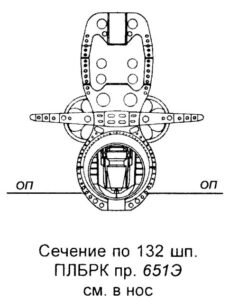 Their crew was “limited” to 78 men compared to 104-109 on an ECHO II. Granted, the latter had twice as much missiles. Just like for the ECHO II there was a radar mount installed inside the fin’s (conning tower) nose. It made a 180° turn, and the radar, stowed top down, was revolved up, and the antenna fully deployed (A marvel of Soviet 1960 engineering) to guide the missiles at least at the start of their trajectory, a long range aircraft being needed to over the horizon accuracy (or an helicopter).
Their crew was “limited” to 78 men compared to 104-109 on an ECHO II. Granted, the latter had twice as much missiles. Just like for the ECHO II there was a radar mount installed inside the fin’s (conning tower) nose. It made a 180° turn, and the radar, stowed top down, was revolved up, and the antenna fully deployed (A marvel of Soviet 1960 engineering) to guide the missiles at least at the start of their trajectory, a long range aircraft being needed to over the horizon accuracy (or an helicopter).
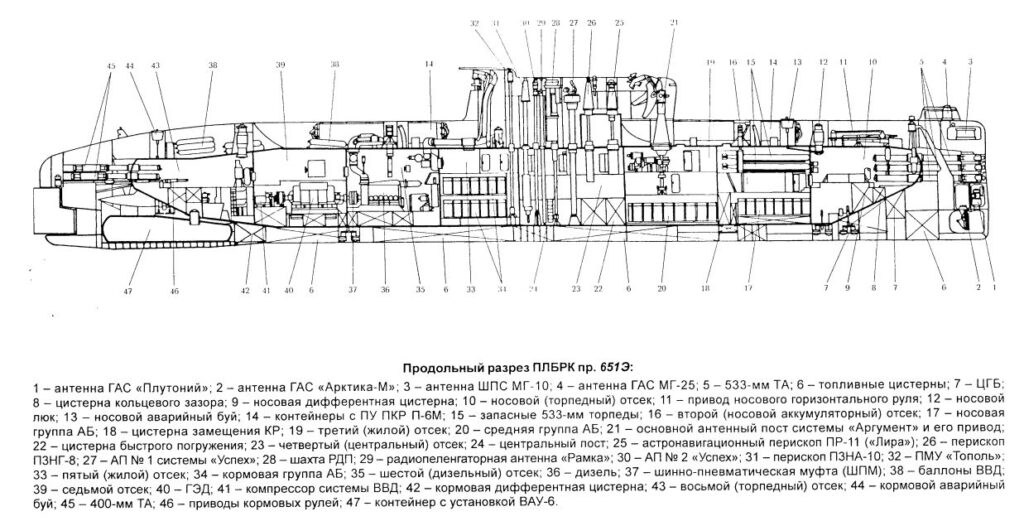
The double-hull design’s inner hull was divided into 8 compartments by armoured bulkheads supposed to held off pressure down to 350m:
1-Bow torpedo compartment;
2-Living/battery compartment;
3-Missile/battery compartment;
4-Control compartment;
5-Living/battery compartment;
6-Diesel engines and diesel generator.
7-Electric motor compartment;
8-Aft torpedo compartment.
The outer hull on the first boats was made of low-magnetic steel, but after several years of operation, cracks were discovered so subsequent project 651 boats returned to ordinary steel, albeit with a special coating, starting with the eighth in line, K-81. This soundproofing layer was made of 50 mm thick (2 inches) rubber panels.
Living conditions were significantly improved compared to previous projects with personnel provided their own individual sleeping berths. Living quarters were in compartments 1,2,3,7,8. There was a general ship ventilation system and deshumidifiers plus electric heaters, as well as steam batteries that can be connected to an external power source as well as refrigerators. The free space was increased as well. Overall, sailors comoing from older boats such as the project 613 found them remakably roomy and comfy for the Soviet standards of the time.
Powerplant
The Juliett class was powered by a diesel-electric arrangement comprising two 4,000-metric-horsepower (2,900 kW) 1D43 diesel engines and two 3,000 PS (2,200 kW) MG-141 electric motors used for cruising surfaced. There were in addition two additional 200 PS (150 kW) electric motors known as “creeping engines”, very silent for slow speeds underwater approaches, powered by four banks of lead-acid battery SAB 30/3 or 48CM cells. The latter were reloaded by a 1,000 PS (740 kW) 1DL42 diesel generator. All these made for a rather complicated but redundant machinery. By working out power distribution, this ensured these boats to always have power. And this worked as the Juliett had a great safety record.
Project 651 boats had if course the usual retractable snorkel to run underwater, but this had limits between the noise emitted and aerial patrols. Top speed surfaced was not bas at 16 knots (30 km/h; 18 mph) despite their bulk, and while snorkeling they stil could go for 18,000 nautical miles (33,000 km; 21,000 mi) at 7 knots (13 km/h; 8.1 mph). Under electric propulsion alone underwater this range went down to 810 nmi (1,500 km; 930 mi) at 2.74 knots (5.07 km/h; 3.15 mph) given the battery technologyue of the time, a far cry from the ECHOs but that was not the point. Underwater they still could achieve 18 knots (33 km/h; 21 mph) but over only 27.8 nmi (51.5 km; 32.0 mi), but water resistance caused a considerable noise as stated above.
They always could be resplensihed at seas, but ion normal operations they had supplies for 90 days which was their best yearly patrol time in service.
Armament
Although initially planned to strike coastal targets on the US east and west coast (by crossing the Pacific from Vladivostock by Alaskan waters) doctrinve shfted to the attack of US carrier battle groups and bases. These two pairs of missile launchers were placed ins ections fore and aft of the conning tower or sail. These launchers were identical to gain time to the ECHO’s and deployed the SS-N-3 Shaddock long-range, turbojet cruise missiles. Their only issue was a surface launch. Albeit autmatized, it was slow for a full salvo, thus this was one of the reasons curtailing the number of tubes. Less tubes, but more of cheaper submarines to make for it.
P-5D (SS-N-3c shaddock)
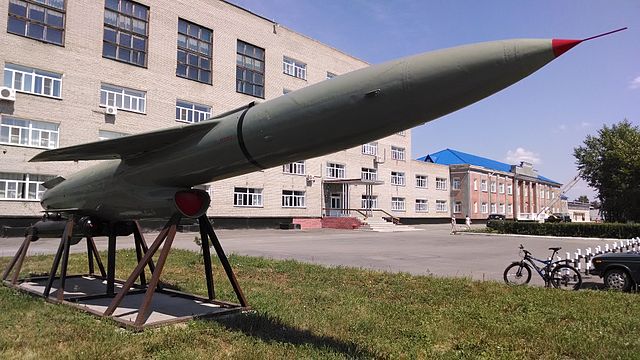
The P-5D was codenamed “SS-N-3c” by NATO. It was a dedicated land-attack missile carrying optionally either an high-explosive, or nuclear warhead. Its “shelf life” was short as itw as retired in 1965–1966.
⚙ specifications SS-N-3c MISSILE |
|
| Weight | 5,000 kg |
| Dimensions | 11.75 m x 0.98m, Wingspan 5 m |
| Propulsion | Turbojet with launch rocket boosters |
| Speed | Mach 0.9 |
| Range | 750 km |
| Guidance | Inertial mid-course via data link, terminal active radar homing (conventional) |
| Payload | 1000 kg conventional or 200-350 kt nuclear |
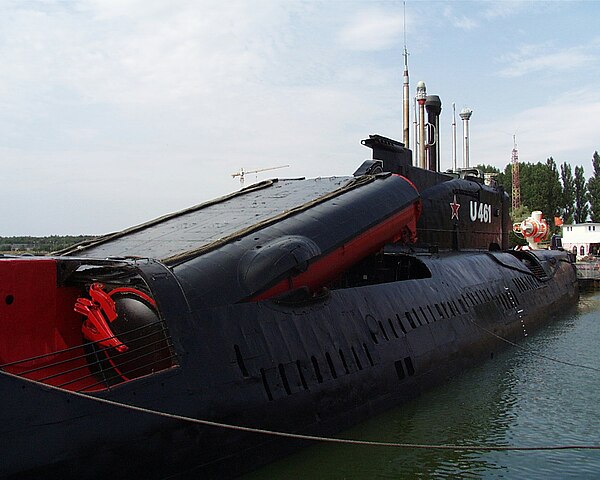
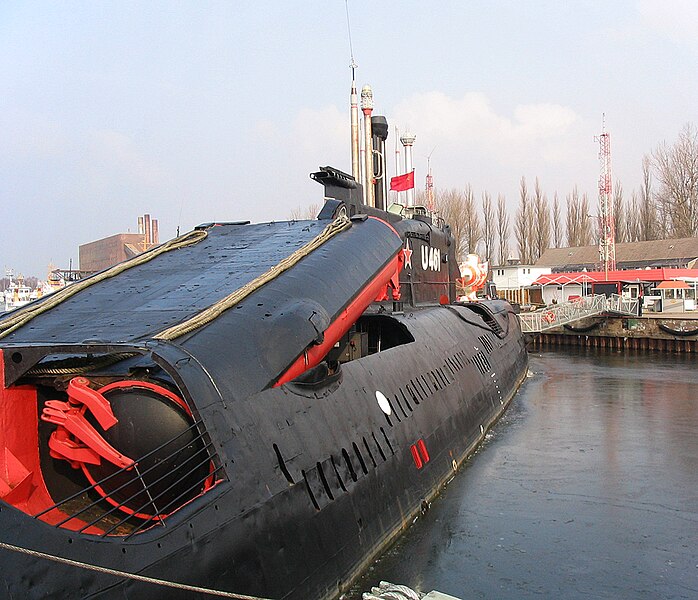
So the main armament as planned were intially four P-5 cruise missiles to deal with stationary coastal targets but soon the P-6 was preferred, to fire on ships. Re-loading a full complement of four missiles from one type of missile to another took about two days, but never happened in practice. The missiles were launched surfaced leaving the carrier exposed for five minutes, and in order to avoid smoke in the air intakes of the rear missiles with exhaust gases from the launch of the front missiles, it was alternated left-right with the rear ones launched first.
P-6 (SS-N-3a shaddock)
It was replaced by the P-6 (SS-N-3a) variant, radar-guided also wth the optional high-explosive and nuclear warhead. Range was reduced by accuracy greatly improved.
⚙ specifications SS-N-3a MISSILE |
|
| Dimensions | 10.20 m, same |
| Range | 450 km |
Once surfaced, five minutes of procedures were needed to launch the first missile, and all three remaining would follow within about 10 seconds each. To replace the P-5 (SS-N-3c Shaddock) using inertial guidance, which was innacurate and condemned them to be more useful with nuclear wahrhead against coastal targets, the P6 was developed to replace it, while ballistic missiles made them obsolete. The SS-N-3a Shaddock was very different and had a shorter range and different guidance in order to attack aircraft carriers. This had all JULIETT class modified with a special 10 m2 target guidance radar built into the forward edge of the sail structure, rotating, as seen above. The flight range of the P-6 cruise missiles exceeded the capabilities of the Juliett’s designation system. So for over the horizon precision the “Uspeh-U” system was used to exchange data with a spotter aircraft, generally the TU-142 “Bear-F”.
Also was tested a variant using the Kasatka satellite downlink for upading targeting information in order to replace the P6 by the mych more capable P-500 4K-80 “Bazalt” (SS-N-12 Sandbox) in order to upgrade the whole serie. But this was never done.
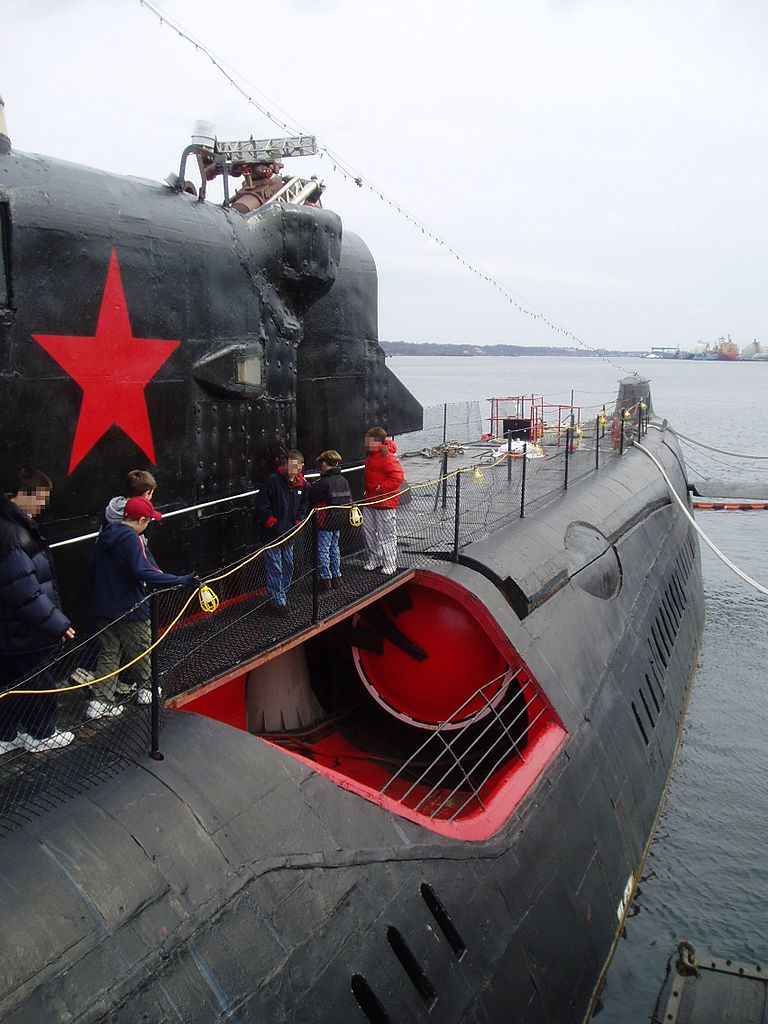
An oblique photo of a Juliett-class submarine showing the aft end of a missile launcher and the blast deflector
533 mm TTs
Traditional armament consisted of six 533 mm (21 inches) torpedo tubes in the bow (so no room for a large sonar) plus and four 406-millimeter (16 inches) torpedo tubes in the stern. Space limitations prevented any reloads for the bow tubes, while each stern tube had two reloads, for a total of twelve. The 22 spare torpedoes were placed in the first and second compartments, on racks. They were reloaded through an additional torpedo loading hatch located between the first and second compartments, under 100 m. Not only the P-5 and P-6 missiles but also the 533 mm torpedoes could be equipped with nuclear warheads.
406 mm TTs
The stern torpedo tubes of 400 mm caliber with ammunition of 12 torpedoes and a firing depth of up to 300 m. The stern torpedo tubes were intended for the ship’s underwater self-defense from attacking enemy submarines.
Fire Control
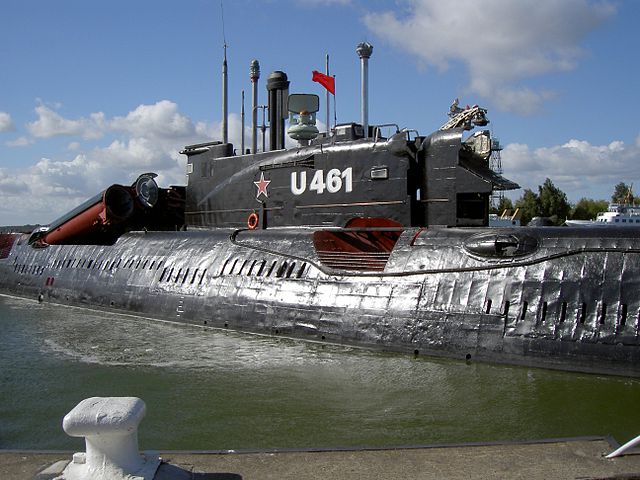
A photo of sister ship K-24 in Peenemünde, Germany. The Argument (Front Door) radar is at the front of the sail, with the Front Piece datalink above it. Aft of the sail, the rear missile mount is visible, elevated to its maximum of 15°.
The P6 relied upon a spotter aircraft for beyond the horizon targeting via the Uspekh-U datalink system. The sail’s own Argument missile-guidance radar (NATO Front Door) controlled the P-6 missiles for the initial phase until out of range via another datalink (NATO Front Piece) and the missile’s onboard radar detected targets, transmitting a TV image back to the submarine via video datalink for final target selection, after which the missile used its own radar for terminal guidance. The Argument radar’s massive antenna that was stowed at the front of the sail, rotated 180° and deployed for use while the “Front Piece” antenna was mounted on top of it.
Sensors
Project 651 boats came out woth the Artika-M (MG-200) and Herkules (MG-15) sonars, as well as the Feniks-M (MG-10) and MG-13 hydrophones. The conninbg tower was given an Albatros RLK-50 search radar (NATO Snoop Tray) and a Nakat-M Electronic warfare support system on another mast.

Base profile by Mike1979Russia, “3d rendition” by the author, under wikimedia CC.
⚙ Juliett specifications |
|
| Displacement | 3,174 t surfaced, 3,750 t submerged |
| Dimensions | 85.9 x 9.7 x 3.29 m (281 ft 10 in x 31 ft 10 in x 10 ft 10 in) |
| Propulsion | 2 shafts diesel (4,000 PS (2,900 kW)), 4× electric motors (3,000 PS/200 PS) |
| Speed | 16 knots surfaced, 18 knots submerged |
| Range | 18,000 nmi (33,000 km; 21,000 mi) at 7 knots snorkeling, 27.8 nmi (51.5 km; 32.0 mi)/18 knots fully submerged |
| Armament | 6× 533 mm (21 in) TTs (12 torpedoes), 4x P-5/6 SSMs, 6x 533mm TTs, 4x 406m TTs |
| Max depht | 240 m (790 ft) |
| Sensors | Artika-M/Herkules sonars, Feniks-M/MG-13 hydrophones, Albatros (RLK-50) radar, Argument FCR, Nakat-M ESM |
| Crew | 78 |
Variants
Unlike other types, especially ealier diesel boats, the Juliett were very specialized and few variants were ever done, but to just improve the concept.
Project 651K
Independent missile guidance and its low reliability by datalinked spotter aircraft (and easy prey for CBG fighters), an attempt was made to create a more reliable system. K-81 was converted according to Project 651K, the installation of the Kasatka-B control equipment complex reloyiong on satellite guidance via an receiving antenna for target designations. It was tested but unfortunately not ported on these boats. No NATO designation.
Project 651E

Diagram of the Project 651E (no NATO designation).
This modification was another one-off proposal to increase range of the Juliett class, but also all diesel submarines at large, by equipping them with a small auxiliary nuclear power plant. The latter was not very powerful, but compact enough to only required minimal transformation and still radically increase autonomy while submerged, a grave issue with the Julietts. This was first developed during tests on K-68, and it soon received the code 651E. It was developed by the Lazurit Central Design Bureau. The impetus were reports of performances degradations after the transition from silver-zinc to standard lead batteries. The nuclear installation was a radical solution to this.
The design team choose the new nuclear power VEU-6, coupled with a TVP-4 reactor, designed by NIKIET, bench tested by NITI. The boiling-water reactor provided a thermal power of 5 MW, and the coupled turbogenerator produced 600 kW. The turbine had a 2.9 m dialeter for 6.5 m in linght for its external cylindrical housing and weighted 70 tons. Engieners found a way to shoehorn it literraly under the boat, obliquelly placed in a niche under the aft compartment outside the pressure hull. There was an access hatch still from the pressure hulled aft compartment to the turbine housing.
This auxiliary nuclear power plant was installed after K86 major overhaul in 1985. More tests made it possible to evaluate its features when using that kind of power plant on diesel submarine. It was as it turned out elss successful than anticipated, procuring a sustained 6 knots underwater for over 7,000 miles. Thus this was not implemented on other boats. In between teams worked on more promising chemical AIP concepts. In 1993, K86 was transferred for disposal and the VAU-6 reactor was found still in good working condition, and without having exhausted its service life. In 2005, the reactor core was unloaded, transferred for disposal.
The Juliett class in service
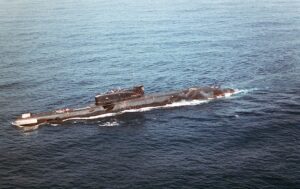
Initial plans called for 35 submarines of this class but only 16 were built. The first two came out from the Baltic Shipyard in St. Petersburg. The remainder was built by the Krasnoye Sormovo Shipyard in Nizhny Novgorod, at breakneck speed. They were commissioned between 1963 and 1968 for an active service up to the early 1980s, albeit they were placed in reserve until and beyond the end of the cold war. The was decommissioned in 1994. The expected delays for producing the nuclear-powered Project 659 (Echo I) and 675 (Echo II) submarines with respectively six and eight missile launchers explaisn why the Julietts were curtailed. After being sent to their northern, Baltic and Paific fleet these “expendable” units could still be used in a circle pre-position around a CBG path (far apart at various azimuths so more difficult to detect and strike all at aonce), or play the role of decoy by launching a grouped attack from a position while ECHOs would attack right after from another.
Note, below are described all 16 subs, however only K-77 is seen in detail due to to her long and very peculiar career. Note that logs cannot be found in lenght either, in the russian language links sourced.
 K-156
K-156
K-156 was built at the Baltic Plant. She was pennanted 552, laid down on November 16 1960, launched July 31 1962, completed December 10, 1963 and assigned to the Northern Fleet. From 1977 she was renamed B-156, and transferred to the Baltic Fleet until retired and scrapped in 1988.
 K-85
K-85
Second and last of tje serie built at the Baltic Plant, pennant 553. She was laid down on October 25, 1961, launched January 31, 1964 and completed on December 30, 1964 assigned to the Northern Fleet and from 1977 she was renamed B-124, being transferred to the Baltic Fleet and also scrapped in 1988.
 K-63
K-63
First built at “Krasnoe Sormovo”, pennant 513, she was laid down on April 25, 1962, launched on July 26, 1963 and completed on December 31, 1964, assigned to the Pacific Fleet, from 1977 renamed B-63, and scrapped in 1991.
 K-70
K-70
Pennant 514, laid down on March 25, 1962, launched February 6, 1964, completed by December 31, 1964, transferred to the Pacific Fleet, from 1987 renamed B-270, scrapped in 1991.
 K-24
K-24
Pennant 511, laid down October 15, 1961, launched July 15, 1962 and completed on October 31, 1965. Assigned to the Northern Fleet, from 1977, renamed B-24, transferred to the Baltic Fleet, sold to Germany in 1994, exhibited in Peenemünde as U461 to this day.
 K-68
K-68
K68 was renamed from 1977 B-68, and from 1990 BS-68. Pennant 512. She was laid down on January 25, 1962, launched April 30, 1963, completed on December 28, 1965, assigned to the Northern Fleet, and from 1977 assigned to the Baltic Fleet. In 1985, modernized according as a project 651E boat. In 1992 she was transferred to the reserve and placed into storage. In 2004 she was transferred for disposal to the Nerpa plant, Murmansk Oblast.
 K-77
K-77
K-77 was built at “Krasnoe Sormovo” yard, identifier 515 from January 31, 1963. On March 11, 1965 until October 31 1965 she served with the Northern Fleet, and from 1977 she was renamed B-77 and transferred to the Baltic Fleet.
Initially laid down as K-77, by March 1963 her crew was formed at the 12th Special Submarine unit of the Northern Fleet, coming from a project 629 boat (Golf class). The command staff was appointed from officers of the 4th Northern Fleet subron; By 1963 March to April 1964 the crew learing about the boat’s structure using drawings and technical descriptions. Practical skills and operations followed and until November 1964, the new boat was towed to the completion yard of the Krasnoye Sormovo plant, Sevastopol. The crew practiced service organization and studied materiel as its detailed operation and exits on another newly completed project 651 from the 153rd Black Sea Fleet Brigade. By November this crew moved to Gorky to discover their submarine, as part of the 104th brigade, Black Sea Fleet, under construction. By March 11 1965, the boat was launched but thetraditional bottle of champagne did not broke on her hull of a submarine due to rubber coating…
Captain 3rd rank N.P. Pavlinov then was more energic and efectictively broke a bottle of rum on her. By March to June 1965 Completion afloat and mooring tests were all made according to plan. By June 1965 K-77 was placed on the TPD-12 floating dock along the Volga, and transited to the Baltic via the Canal to Belomorsk. Underr her own power she sailed to Severodvinsk, delivery base.
This summer 1955 she proceeded to her factory and State sea trials and in October she received her interior decorations and furnishings, she loading her first supplies and on October 31 she officially entered service. In November she joined the Northern Fleetn, 35th Divsioon, 1st Red Banner based at Malaya Lopatkina Bay in Murmansk and moved to this permanent deployment base. In the following years she participated in Northern Fleet exercises and by September 1969 she was moved to HP Ura Bay.
In October 1969 she entered the 9th Special Submarine Squadron.
In April-June 1970 she completed all her combat preparations in the Mediterranean and took part in the Ocean maneuvers. By October 1971 until January 1973 she had her first overhaul at SRZ-35 (Rosta, Murmansk) and in 1973 completed her full combat training course with live Torpedo and missile firing. She also participated in Northern Fleet exercises.
By May 1974 until November she worked in the Mediterranean with the 5th Operational Squadron and shadowed US 6th Fleet”s CBGs of “America”, “Forrestal” and “Independence”. From July 26 to August 4, 1974, she had some maintenance and resupply, crew rest in Alexandria. By Dember 1975 until April 1976 she completed all combat tasks under capt.1r. Levin in the Central Atlantic. While underway she was updated about the information about the passage of the aircraft carrier USS Saratoga to the Mediterranean Sea with her group of 7 escort ships. On 13 January 1976 she was ordered to diverge from the aircraft carrier group, whick sailed to the Greater Antilles, 900 miles east of Puerto Rico. On 7 February she was ordered to proceed to Conakry, Guinea, fopr replenishment and rest, until the 28th. On 10 March 1976 she was ordered to Alexandria for maintenance. On 18 March while off Gibraltar, she was ordered to return to Vidyaevo instead but on the 30th at 01:30 a fire broke out in the 5th compartment in which were present the 3-4 groups of batteries. The fire was extinguished using a freon volumetric extinguishing system. Due to unauthorized freon emission in the 7th compartment instead of the 5th, the electrical engineering captain-lieutenant Anatoly Alekseevich Kochnev, and mechanics commander on watch, died. Petty Officer Paul Karlovich on duty in the remote automatic control of diesel engines put on its IDA-59 mask but lost consciousness and was still able to open the valves, causing oxygen starvation with a fatal outcome. 9 sailors which slept in the compartment regained consciousness after breathing oxygen after ship’s doctor intervened. There was an enquiry.
By April 1977 to December 1978 she was overhauled at SRZ-10 Polyarny and by July 25 she was Renamed B-77. She started her 1978 service campaign under Capt.1r. Eremina and the main crew arrived. From Dec. 1949 to July 1980 she cruised on the Mediterranean and by July 1981 to September she made her sixth and last campaign to the Mediterranean Sea. She was assigned a combat patrol area in the Adriatic, north of the Strait of Tunis. On 23 August, the crew had holidays organized for a change in monotonous service. Meanwhile the boat charged its batteried when at 23.55 an emergency alarm range due to a fire in the 6th compartment, breaking out in the middle diesel engine at the aft bulkhead. Personnel of the 6th compartment fled to the stern, and the compartment was sealed off after which the fire was extinguished. It turned out that before changing the watch, the mechanic on duty was obliged to replenish the fuel tank above the middle diesel engine and checked the full filling supply tank through the ventilation tube, but apparently the diesel fuel flowed with great pressure through the edges of the funnel and landed right on the diesel manifold at 700 degrees. There were no injuries. Medical care was given to the returning crew.
By September 1989 to March 1991 March B-77 had her last major overhaul at SRZ-35 in Murmansk but her unit the 35th Brigade was disbanded and she was transferred to the 7th Brigade, 9th Operational Squadron. In August 1991 she carried a cruise around Scandinavia from Vidyaevo to Liepaja and in September she was reassigned to the 58th Brigade in Liepaja. By July 1993 she took part in the Navy parade in Baltiysk with a documentary was made about this Navy Day by DKBF. By October 1993 October she was transferred to the 22nd Brigade of the Baltic Fleet, Kronstadt and in Feb. 1994 she was withdrawn from the permanent readiness forces, transferred to the reserve. In April she was stricken and prepared for inactivation.
JULY 1994: She was Sold by Latvia to Finnish merchant Jari Komulainen (Sub-Expo Ltd.), showed to representatives of insurance and towing companies and moved to Finland, Helsinki and mlodified to receive a bar and restaurant, renamed “U-484”. She was then leased for five years to Canadian Submarine B.C. at 200,000 US dollars yealy. By 1997-1998 she was towed across the Atlantic to Tampa Bay in Florida, tourist harbor at St. Petersburg. She was sub-leased for 30-month as an attraction moored to the city pier. However her draft was too great, and she was anchored far away instead, with the transporting tourists by speedboats. In 1998-1999 “U-484″was visited by more than 50,000 visitors. But this never covered all costs and by February 1999, thre Canadian company “Russian Submarine B.C.” filled a bankruptcy note. The sub was and sealed and Sub-Expo Ltd. in turned sold it for $1,000,000. By 2000, InterMedia Film Equities Ltd. looked for her to film “K-19: The Widowmaker” and rented her for $200,000. The sub was towed over 2,000-mile over 2-week to Halifax, docked.
 In 2000-2001 she was altered to impersonate the K19, an Hotel class, with “plastic surgery” on her sail extended by 25-meter and a nozzle installed at the stern, topped with a characteristic ridge, plus a huge three ballistic missiles fake extension. Thus, she was filmed for real instead of going for CGIs; giving the movie its relative authenticity, including for navy buffs.
In 2000-2001 she was altered to impersonate the K19, an Hotel class, with “plastic surgery” on her sail extended by 25-meter and a nozzle installed at the stern, topped with a characteristic ridge, plus a huge three ballistic missiles fake extension. Thus, she was filmed for real instead of going for CGIs; giving the movie its relative authenticity, including for navy buffs.
The filiming was done in April-May 2001 after her actual exit from the floating dock. All was done at the main base of the Royal Canadian Navy for the light quality replicating Murmansk.
After filming, she was on public display at $50 per ticket, but it vaned after a while. The carrier Saratoga museum in Providence then declared its interest, trying to enchance attractivity of the former US Naval Air Station Quonset Point in Rhode Island. Funding campaign started for the upcoming U-484.
By March 22-25 2002 she was towed from Halifax to Providence and prepared to open to the public. Work went on for several months and she opened in August. In April 2007 there was however a strong storm and the hull was damaged, listing port, trimmed to the stern, and by evening she sank at the pier. She was examined in April-May and in August preparatory work was done for lifting her with army landing ship 2031 New Orleans in support and diving platform, it was performed by July 2008 using hydraulic pumps and she was inflated up and secured on pontoons. By May 2010 funs were lacking to restore her. She was this time sold for scrap…
 K-58
K-58
Pennant 521, laid down July 15, 1963, launched December 1966, completed on September 23, 1966 assigned to the Northern Fleet, from 1977 renamed B-58. Sank while moored in 1992, scrapped.
 K-73
K-73
Pennant 523, laid down August 11, 1964, launched May 31, 1966 and completed on December 15, 1966, assigned to the Pacific Fleet, by 1977 she was renamed B-73, scrapped in 1991.
 K-67
K-67
Pennant 524, laid down on January 31, 1965, launched October 29, 1966, completed September 30, 1967, assigned to the Black Sea Fleet, and from 1977 renamed B-67. Scrapped in 1994.
 K-78
K-78
Pennant 525, laid down July 25 1965, launched March 30 1967 and completed on January 11, 1967. Assigned to the Northern Fleet and from 1977 she was renamed B-478, transferred to the Baltic Fleet, Withdrawn from service in 1994, abandoned in Latvia, scrapped.
 K-203
K-203
Pennant 531, laid down December 25 1965, launched June 30 1967, completed December 2 1967, assigned to the Northern Fleet and from 1977 renamed B-203. Transferred to the Baltic Fleet. Scrapped in 1994.
 K-304
K-304
Pennant 532, laid down on August 6 1966, launched January 24 1967, completed September 21 1968. Assigned to the Northern Fleet and from 1977 renamed B-304. Scrapped in 1994.
 K-318
K-318
Pennant 533, laid down March 29 1966, launched March 29 1968, completed on September 29 1968. Assigned to the Black Sea Fleet and from 1977 renamed B-318. Srapped in 1994.
 K-120
K-120
Pennant 534; laid down on March 25 1967, launched July 11 1968, completed by December 26 1968. Pacific Fleet, from 1987 B-120. Scrapped in 1991.
Epilogue
14 out of 16 boats were scrapped with the remaining two sold abroad, B-24 to Germany in 1994. She became a museum ship sporting the random designation “U-461”. In 2010, she remained the world’s last in existence. Indeed B-77 meanwhile was sold to a Finnish businessman who built a themed restaurant inside. It was apparently not successful and the boat was resold to an American company, towed to the USA. From 1997, it was berthed and used as a tourist attraction in St. Petersburg, Florida. In 2000-2001 she was painted with the identifier K-19 to portray the boat in the movie of the same name. Scenes were also filmed inside. From 2002 to 2007, she became a museum in Providencen close to the former essex class Saratoga. She earned a red star and was designated “U-484”. But a typical Florida spring Storm on April 17, 2007 had her breaking loose from her moorings and being tossed against the berth, and so damaged she sank the next day, completely flooded. The lack of proper maintenance also explains this. She was raised 15 months later, but with repairs costs estimated at $1 million, she was sopld to a scrapyard in May 2010.
Read More/Src
Books
Conway’s all the world’s fighting ships 1947-95.
Submarine K-77. Project history.
The VAU-6 auxiliary nuclear power plant is a Russian version of an air-independent power plant for diesel submarines.
History of the creation and trial operation of the Project 651E submarine with the VAU-6 auxiliary nuclear power plant. I. V. Ivanov.
Project 651 (NATO – Juliett). 2003-2004. ruspodlodka.narod.ru.
S. Aprelev “Metamorphoses of K-77”.
K-77 – Submarine K-77.
K-77, B-77, “U-484” project 651, deepstorm.ru.
K-81 modified according to project 651K.
K-58, B-58 project 651.
Links
web.archive.org book.uraic.ru/
web.archive.org www.k-77.com/k77/
web.archive.org/ rusdarpa.ru/
rusdarpa.ru/?p=331
web.archive.org 651.htm
deepstorm.ru/ 77.htm
www.k-77.com/rus/
deepstorm.ru/ K-77.htm
deepstorm.ru/ 651/List.htm
web.archive.org/ fkea_2013.pdf
u-461.de/
en.wikipedia.org Juliett-class_submarine
ru.wikipedia.org/ B0_651

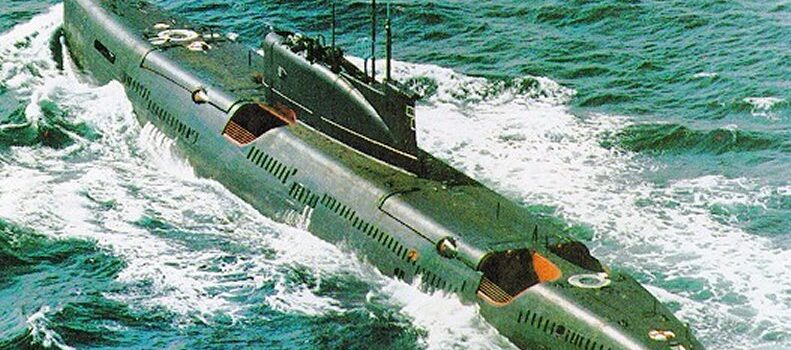
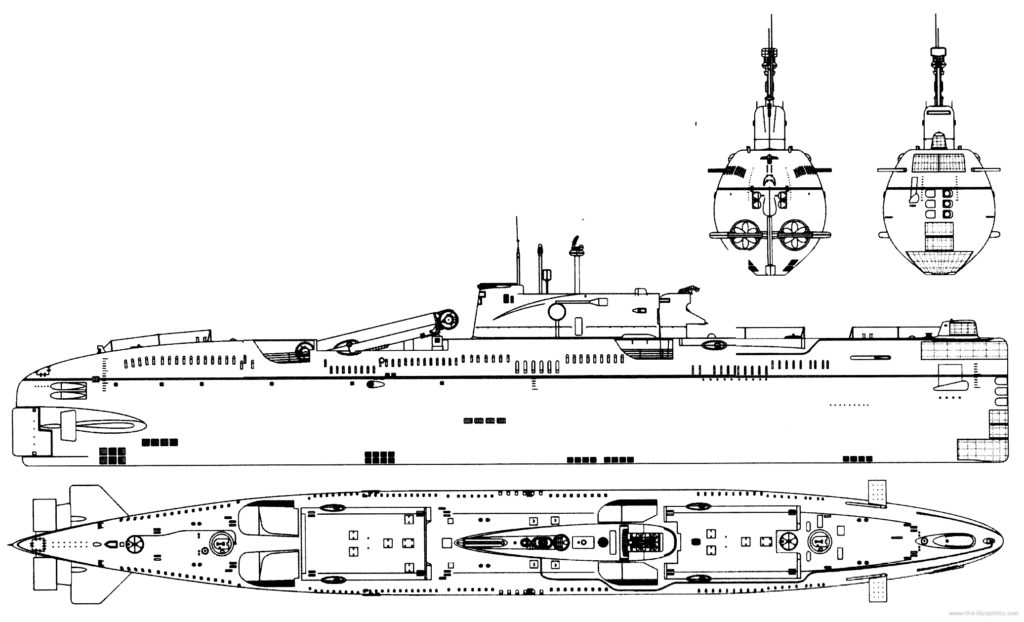
 Latest Facebook Entry -
Latest Facebook Entry -  X(Tweeter) Naval Encyclopedia's deck archive
X(Tweeter) Naval Encyclopedia's deck archive Instagram (@navalencyc)
Instagram (@navalencyc)





 French Navy
French Navy Royal Navy
Royal Navy Russian Navy
Russian Navy Armada Espanola
Armada Espanola Austrian Navy
Austrian Navy K.u.K. Kriegsmarine
K.u.K. Kriegsmarine Dansk Marine
Dansk Marine Nautiko Hellenon
Nautiko Hellenon Koninklije Marine 1870
Koninklije Marine 1870 Marinha do Brasil
Marinha do Brasil Osmanlı Donanması
Osmanlı Donanması Marina Do Peru
Marina Do Peru Marinha do Portugal
Marinha do Portugal Regia Marina 1870
Regia Marina 1870 Nihhon Kaigun 1870
Nihhon Kaigun 1870 Preußische Marine 1870
Preußische Marine 1870 Russkiy Flot 1870
Russkiy Flot 1870 Svenska marinen
Svenska marinen Søværnet
Søværnet Union Navy
Union Navy Confederate Navy
Confederate Navy Armada de Argentina
Armada de Argentina Imperial Chinese Navy
Imperial Chinese Navy Marinha do Portugal
Marinha do Portugal Mexico
Mexico Kaiserliche Marine
Kaiserliche Marine 1898 US Navy
1898 US Navy Sovietskiy Flot
Sovietskiy Flot Royal Canadian Navy
Royal Canadian Navy Royal Australian Navy
Royal Australian Navy RNZN Fleet
RNZN Fleet Chinese Navy 1937
Chinese Navy 1937 Kriegsmarine
Kriegsmarine Chilean Navy
Chilean Navy Danish Navy
Danish Navy Finnish Navy
Finnish Navy Hellenic Navy
Hellenic Navy Polish Navy
Polish Navy Romanian Navy
Romanian Navy Turkish Navy
Turkish Navy Royal Yugoslav Navy
Royal Yugoslav Navy Royal Thai Navy
Royal Thai Navy Minor Navies
Minor Navies Albania
Albania Austria
Austria Belgium
Belgium Columbia
Columbia Costa Rica
Costa Rica Cuba
Cuba Czechoslovakia
Czechoslovakia Dominican Republic
Dominican Republic Haiti
Haiti Hungary
Hungary Honduras
Honduras Estonia
Estonia Iceland
Iceland Eire
Eire Equador
Equador Iran
Iran Iraq
Iraq Latvia
Latvia Liberia
Liberia Lithuania
Lithuania Mandchukuo
Mandchukuo Morocco
Morocco Nicaragua
Nicaragua Persia
Persia San Salvador
San Salvador Sarawak
Sarawak Uruguay
Uruguay Venezuela
Venezuela Zanzibar
Zanzibar Warsaw Pact Navies
Warsaw Pact Navies Bulgaria
Bulgaria Hungary
Hungary

 Bundesmarine
Bundesmarine Dutch Navy
Dutch Navy Hellenic Navy
Hellenic Navy Marina Militare
Marina Militare Yugoslav Navy
Yugoslav Navy Chinese Navy
Chinese Navy Indian Navy
Indian Navy Indonesian Navy
Indonesian Navy JMSDF
JMSDF North Korean Navy
North Korean Navy Pakistani Navy
Pakistani Navy Philippines Navy
Philippines Navy ROKN
ROKN Rep. of Singapore Navy
Rep. of Singapore Navy Taiwanese Navy
Taiwanese Navy IDF Navy
IDF Navy Saudi Navy
Saudi Navy Royal New Zealand Navy
Royal New Zealand Navy Egyptian Navy
Egyptian Navy South African Navy
South African Navy






























 Ukrainian Navy
Ukrainian Navy dbodesign
dbodesign